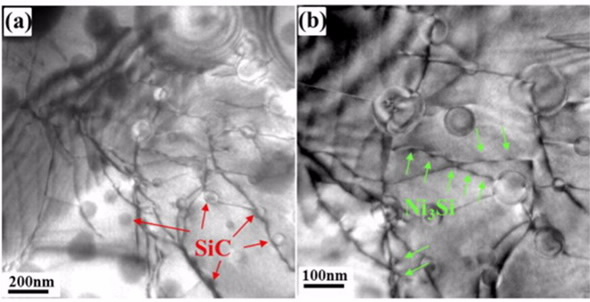 |
| Bright field TEM images of (a) dislocation pinned by SiC particle and (b) Ni3Si precipitates |
ANSTO has joined a Sino-Australian project and contributed significantly to research clarifying the origin of the superior mechanical properties in a new class of materials for use in the next generation of molten salt reactors (MSRs).
MSRs, advanced Generation IV concept reactors, have advantages over conventional nuclear reactors because of inherent safety, fuel cycle capabilities and efficiencies and low operating pressure.
The newly developed class of NiMo-SiC alloys has the potential to be used not only in MSRs but also in concentrated thermo-solar energy systems, which also use molten salt as the heat transfer and heat storage medium.
Although no commercial MSRs are currently in operation worldwide, there is a molten salt reactor and thorium energy research and development program at the Shanghai Institute of Applied Physics (SINAP).
 |
ANSTO has an international partnership agreement with SINAP.
Structural materials for MSRs must demonstrate strength at high temperatures, be radiation resistant and also withstand corrosion.
The development of this new class of NiMo-SiC alloys was initiated at SINAP by Mr Chao Yang and Dr. Hefei Huang. In this effort, a number of Ni-MoSiC alloy specimens containing varying amount of SiC were then prepared in SINAP laboratories before being characterised at ANSTO.
In a paper published in Materials and Design, researchers from SINAP and ANSTO, reported that these novel NiMo-SiC alloys, prepared from nickel (Ni) molybdenum (Mo) metal powders with added silicon carbide (SiC) particles possess superior mechanical properties owing to the precipitation, dispersion and solid-solution strengthening of the NiMo matrix.
The preparation includes mechanical alloying, spark plasma sintering, rapid cooling, high temperature annealing and water quenching.
Chao Yang, a PhD student from SINAP, worked for 12 months at ANSTO with Dr Ondrej Muránsky, Dr Hanliang Zhu, and Prof Gordon Thorogood on the comprehensive characterisation of the microstructure of these new alloys using neutron, synchrotron and electron diffraction techniques available at ANSTO.
Although the dispersion strengthening benefits of adding silicon carbide (SiC) particles to nickel (Ni) had been known, it was not considered satisfactory for use in MSRs due to the low high-temperature strength.
This issue has been addressed in the newly developed NiMo-SiC alloys by the presence of nickel silicide (Ni3Si) nano-particles, which fill the space between SiC particles, and thus hinder the dislocation motion (see image above).
Because these alloys are developed via a powder metallurgy process, the SiC and Ni3Si are uniformly distributed within the NiMo matrix.
Such uniform distribution of SiC particles would not be possible to achieve using standard metallurgy processes.

Hence, the strength of these alloys stems from the combination of dispersion strengthening by SiC particles, precipitation strengthening by Ni3Si and solid-solution strengthening by Mo.
In addition to dispersion strengthening by SiC particles and precipitation strengthening by Ni3Si, the NiMo matrix is strengthened by the presence of molybdenum (Mo) atoms, which form the solid-solution of NiMo.
As well as superior high-temperature strength, these newly developed alloys have superior corrosion resistance and radiation damage resistance.
The nano-particles present in the microstructure not only provide the obstacles for dislocation motion, but also provide sites/traps for radiation damage effects.
http://dx.doi.org/10.1016/j.matdes.2016.10.024
Published: 07/02/2017


